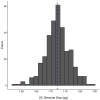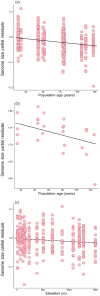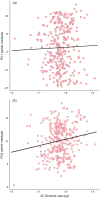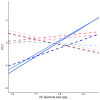Genome size variation and evolution during invasive range expansion in an introduced plant
- PMID: 38283607
- PMCID: PMC10810172
- DOI: 10.1111/eva.13624
Genome size variation and evolution during invasive range expansion in an introduced plant
Abstract
Plants demonstrate exceptional variation in genome size across species, and their genome sizes can also vary dramatically across individuals and populations within species. This aspect of genetic variation can have consequences for traits and fitness, but few studies attributed genome size differentiation to ecological and evolutionary processes. Biological invasions present particularly useful natural laboratories to infer selective agents that might drive genome size shifts across environments and population histories. Here, we test hypotheses for the evolutionary causes of genome size variation across 14 invading populations of yellow starthistle, Centaurea solstitialis, in California, United States. We use a survey of genome sizes and trait variation to ask: (1) Is variation in genome size associated with developmental trait variation? (2) Are genome sizes smaller toward the leading edge of the expansion, consistent with selection for "colonizer" traits? Or alternatively, does genome size increase toward the leading edge of the expansion, consistent with predicted consequences of founder effects and drift? (3) Finally, are genome sizes smaller at higher elevations, consistent with selection for shorter development times? We found that 2C DNA content varied 1.21-fold among all samples, and was associated with flowering time variation, such that plants with larger genomes reproduced later, with lower lifetime capitula production. Genome sizes increased toward the leading edge of the invasion, but tended to decrease at higher elevations, consistent with genetic drift during range expansion but potentially strong selection for smaller genomes and faster development time at higher elevations. These results demonstrate how genome size variation can contribute to traits directly tied to reproductive success, and how selection and drift can shape that variation. We highlight the influence of genome size on dynamics underlying a rapid range expansion in a highly problematic invasive plant.
Keywords: flow cytometry; intraspecific genome size variation; invasive species; yellow starthistle.
© 2023 The Authors. Evolutionary Applications published by John Wiley & Sons Ltd.
Conflict of interest statement
The authors declare no conflict of interest.
Figures






Similar articles
-
Native and Invading Yellow Starthistle (Centaurea solstitialis) Microbiomes Differ in Composition and Diversity of Bacteria.mSphere. 2019 Mar 6;4(2):e00088-19. doi: 10.1128/mSphere.00088-19. mSphere. 2019. PMID: 30842267 Free PMC article.
-
Population genomic analyses reveal a history of range expansion and trait evolution across the native and invaded range of yellow starthistle (Centaurea solstitialis).Mol Ecol. 2017 Feb;26(4):1131-1147. doi: 10.1111/mec.13998. Epub 2017 Feb 4. Mol Ecol. 2017. PMID: 28029713 Free PMC article.
-
Expansion history and environmental suitability shape effective population size in a plant invasion.Mol Ecol. 2019 May;28(10):2546-2558. doi: 10.1111/mec.15104. Epub 2019 May 21. Mol Ecol. 2019. PMID: 30993767 Free PMC article.
-
The hidden side of plant invasions: the role of genome size.New Phytol. 2015 Feb;205(3):994-1007. doi: 10.1111/nph.13107. Epub 2014 Oct 17. New Phytol. 2015. PMID: 25323486 Review.
-
Contemporary evolution during invasion: evidence for differentiation, natural selection, and local adaptation.Mol Ecol. 2015 May;24(9):1999-2017. doi: 10.1111/mec.13162. Epub 2015 Apr 20. Mol Ecol. 2015. PMID: 25891044 Review.
Cited by
-
Chromosome-scale Reference Genome and RAD-based Genetic Map of Yellow Starthistle (Centaurea solstitialis) Reveal Putative Structural Variation and QTL Associated With Invader Traits.Genome Biol Evol. 2024 Dec 4;16(12):evae243. doi: 10.1093/gbe/evae243. Genome Biol Evol. 2024. PMID: 39592405 Free PMC article.
-
Genome Size Variation in Sesamum indicum L. Germplasm from Niger.Genes (Basel). 2024 May 29;15(6):711. doi: 10.3390/genes15060711. Genes (Basel). 2024. PMID: 38927647 Free PMC article.
-
New estimates and synthesis of chromosome numbers, ploidy levels and genome size variation in Allium sect. Codonoprasum: advancing our understanding of the unresolved diversification and evolution of this section.Bot Stud. 2024 Dec 24;65(1):40. doi: 10.1186/s40529-024-00446-8. Bot Stud. 2024. PMID: 39718713 Free PMC article.
-
Chromosome-scale reference genome of Pectocarya recurvata, the species with the smallest reported genome size in Boraginaceae.Appl Plant Sci. 2025 May 21;13(3):e70008. doi: 10.1002/aps3.70008. eCollection 2025 May-Jun. Appl Plant Sci. 2025. PMID: 40575554 Free PMC article.
References
-
- Achigan‐Dako, E. G. , Fuchs, J. , Ahanchede, A. , & Blattner, F. R. (2008). Flow cytometric analysis in Lagenaria siceraria (Cucurbitaceae) indicates correlation of genome size with usage types and growing elevation. Plant Systematics and Evolution, 276(1–2), 9–19. 10.1007/s00606-008-0075-2 - DOI
-
- Baker, H. G. (1974). The evolution of weeds. Annual Review of Ecology and Systematics, 5(1), 1–24.
-
- Bancheva, S. , & Greilhuber, J. (2006). Genome size in Bulgarian Centaurea s.l. (Asteraceae). Plant Systematics and Evolution, 257(1–2), 95–117. 10.1007/s00606-005-0384-7 - DOI
-
- Barker, B. S. , Andonian, K. , Swope, S. M. , Luster, D. G. , & Dlugosch, K. M. (2017). Population genomic analyses reveal a history of range expansion and trait evolution across the native and invaded range of yellow starthistle (Centaurea solstitialis). Molecular Ecology, 26(4), 1131–1147. 10.1111/mec.13998 - DOI - PMC - PubMed
LinkOut - more resources
Full Text Sources

